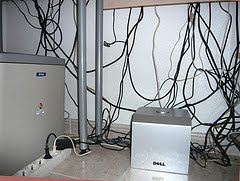
I was not raised in the Christmas tradition.
I didn't grow up with that uninvited house guest that camped illegally under Christmas trees of yore. The burglar scrooge charged with breaking and entering was not so much an unwelcome villain as the batteries not included; the post assembly part of the toys outsourced by Santa and the Elfs to the bumbling parents who give instructions but can't seem to follow them.
Not only do my Neanderthal mechanics compromise all D-I-Y home improvements and quests to IKEA for end tables. They also jeopardize the geeky gadgets that unhandy knowledge managers like me are supposed to hit out of the office park.
By the time I'd retraced every false move along the installation path I was positive I had mistaken a power cable for a plastic bag taggie. I should have been consoled if not vindicated when I got back the following message from "Monty A" of the "HP E-Mail Technical Support Team." Monte's reply arrived nearly an hour to the moment I dispatched my New Year's SOS to tech support re: HP Deskjet F4480 All-in-one printer:
I understand from your E-mail that you don’t receive USB cable.
Marc, I would like to inform you that the all-in-one devices, including your HP All-in-One printer, are not shipped with a USB cable. Initially the all-in-one devices were shipped with a USB cable but the majority of the customers complained that they did not need the printer cable for the reasons listed below.
1. Many customers already have a cable and do not require another cable.
2. Many customers use their all-in-one product as a standalone fax and/or copier and do not require a cable.
3. Many customers require a specific length of cable to fit within their physical work environment. If a cable shipped with their All-in-one product and did not meet their needs, they would have to buy another cable.
Wow. Apparently in the US of A there are no longer any US of Bs nestled in the packing foam air pockets of any HP deskjet boxes. The message nuancer in me had to concede a deft display of double-talk from the Deskjet Kings.
Monty continues:
Since the cost of the printer cable is more, customers had to unnecessarily bear the cost of the USB cable which would in turn increase the cost of the product. Taking all the reasons listed above into account, HP decided not to ship a USB cable with the all-in-one products. This allows customers to purchase the printer cable, if needed.
Holy moley, mealy-mouthed purchaser wipes the dull glaze from his post holiday mug and concludes:
* Us desk-jetters are a restless bunch. We all insist on a divergent range of distances for trailing a printer to our desktoppers. No calculation by the manufacturer is apparently elastic enough to handle the lengths we'll go to situate our hardware.
* Gee if I'd only taken a collection back in 1987 for every 9 volt AC unit shipped with an answering machine there might be enough spare landfill for all the bulbous, parched monitors left out on the curb with today's Christmas trees.
* The all-in-oners don't need another USB clogging their memory ports. I should turn to the index in the manual to see about faxing all those scans to the cloud where no one can hear U SB, least of all Monty A.
In the end we all get what we deserve:
1. A second trip to the retailer for presumptuous consumers like me (that can't help but jumpkick us down the path to economic rebootery).
2. Printer plugs that now join the hallowed stocking grounds of "peripherals" like backup drives, CD burners and ear bud warmers that never grow long in the Blue Tooth.
3. And to the winner HP gets to pocket the spoils. Now if they could only degrade the pins that connect the components they market they could sell us replacement cartridges on those frayed, scorched, and twisted printer cables.
That would be thinking and shipping outside the box.


No comments:
Post a Comment